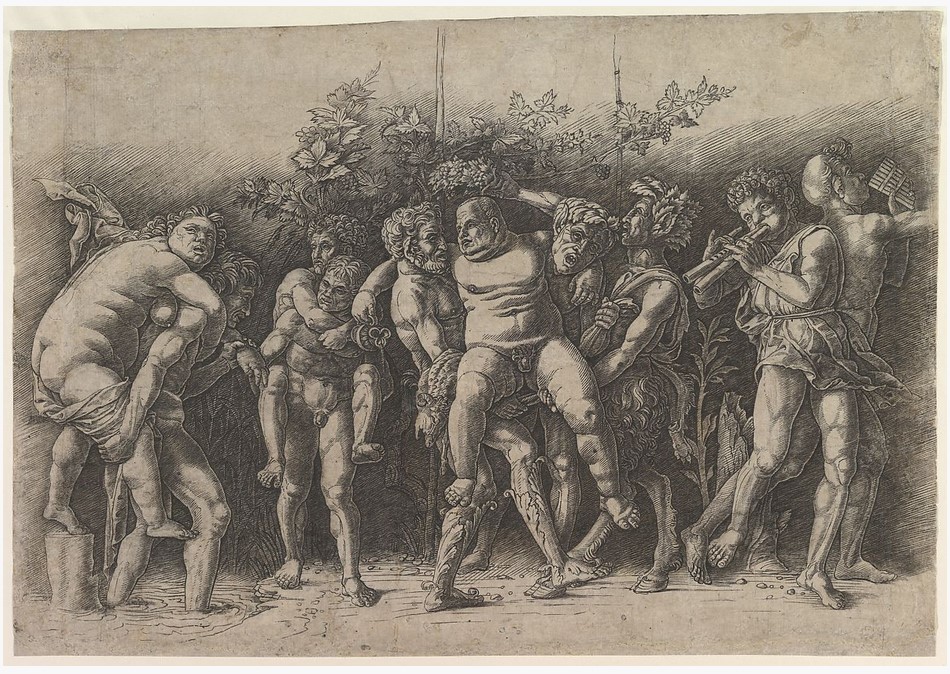
Mostly Mantegna
In s2e9, co-hosts Ann Shafer and Tru Ludwig continue their conversation about early Italian printmaking with a strong focus on the engravings of Andrea Mantegna. They also talk about chiaroscuro woodcuts, always keeping the North within eyesight.
Episode image: Andrea Mantegna (Italian, c. 1431–1506). Risen Christ between Saints Andrew and Longinus, c. 1470/75. Engraving. Sheet: 329 x 306 mm. (12 15/16 x 12 1/16 in.). National Gallery of Art, Washington, D.C.
Master E.S. (German, active c. 1450–1467). St. Matthias, c. 1450–60. Engraving. Sheet (trimmed within platemark): 149 × 89 mm. (5 7/8 × 3 1/2 in.). Baltimore Museum of Art, Baltimore.
Master of the E-Series Tarocchi (Italian, active c. 1465). Polyhymnia, c. 1465. Engraving with hand coloring. Sheet: 185 × 105 mm. (7 5/16 × 4 1/8 in.); plate: 180 × 99 mm. (7 1/16 × 3 7/8 in.). Baltimore Museum of Art, Baltimore.
Antonio Pollaiuolo (Italian, c. 1432–1498). Hercules and Antaeus, c. 1475–80. Bronze. Museum Nazionale del Bargello, Florence, Italy.
Hubert van Eyck (Netherlandish, 1370–1426) and Jan van Eyck (Netherlandish, 1390–1441). Adoration of the Mystic Lamb or The Ghent Altarpiece, 1432. Oil and tempera on wood. 138 x 181 in. St. Bavo’s Cathedral, Ghent, Belgium.
Masaccio (Italian, 1401–1428). The Holy Trinity with the Virgin and St. John and donors, 1425–27. Fresco painting in chapel. 236 x 125 in. in Santa Maria Novella, Florence, Italy.
Antonio Pollaiuolo (Italian, c. 1432–1498). Battle of the Ten Nude Men, c. 1490. Engraving. Sheet (trimmed within platemark): 384 x 589 mm. (15 1/8 x 23 3/16 in.). Metropolitan Museum of Art, New York.
Johannes de Ketham (German, 15th century). Fasciculus Medicinae, 1491. Bound volume published in Venice.
Francesco Colonna (Italian, 1433/34–1527). Hypnerotomachia Polyphili, 1499. Bound volume published in Venice.
Lucas Cranach the Elder (Germany, 1472–1553). Saint Christopher, c. 1509. Chiaroscuro woodcut printed in black and red-brown. Image: 11 x 7 1/2 in. (279 x 191 mm.). Minneapolis Institute of Arts, Minneapolis.
Ugo da Carpi (Italian, c. 1470–1532), after Titian (Italian, 1489/90–1576). St Jerome in the desert seated facing left, c.1516. Chiaroscuro woodcut with two color blocks in green. Sheet: 156 x 95 mm. British Museum, London.
Ugo da Carpi (Italian, c. 1470–1532), after Parmigianino (Italian, 1503–1540). Diogenes, c. 1527–30. Chiaroscuro woodcut printed from four blocks in gray-green. Image: 18 11/16 x 13 5/8 in. (475 x 346 mm.). Metropolitan Museum of Art, New York.
Andrea Mantegna (Italian, c. 1431–1506). Camera degli Sposi, Gonzaga Ducal Palace, Mantua, Italy.
Andrea Mantegna (Italian, c. 1431–1506). The Entombment, 1465–75. Engraving. Sheet (trimmed within plate): 229 x 439 mm. Art Institute of Chicago, Chicago.
Ara Pacis Augustae, 13 BCE. Rome.
Andrea Mantegna (Italian, c. 1431–1506). Risen Christ between Saints Andrew and Longinus, c. 1470/75. Engraving. Sheet: 329 x 306 mm. (12 15/16 x 12 1/16 in.). National Gallery of Art, Washington, D.C.
Andrea Mantegna (Italian, c. 1431–1506). Bacchanal with Silenus, before 1475. Engraving with drypoint. Sheet: 12 in. × 17 1/4 in. (305 × 438 mm.). Metropolitan Museum of Art, New York.
Andrea Mantegna (Italian, c. 1431–1506). Bacchanal with a Wine Vat, c. 1470–90. Engraving and drypoint. Sheet: 11 3/4 x 17 3/16 in. (299 x 437 mm.). Metropolitan Museum of Art, New York.
Andrea Mantegna (Italian, c. 1431–1506). Battle of the Sea Gods, 1470s. Engraving and drypoint. Sheet: 340 x 451 mm. (13 ¼ x 17 ¾ in.). Minneapolis Institute of Arts, Minneapolis.
Andrea Mantegna (Italian, c. 1431–1506). St Sebastian, c. 1506. Tempera on canvas. 213 x 95 cm. Galleria Franchetti, Ca' d'Oro, Venice.
Andrea Mantegna (Italian, c. 1431–1506). Lamentation over the Dead Christ, c. 1483. Tempera on canvas. 680 x 810 mm. Pinacoteca di Brera, Italy.
Albrecht Dürer (German, 1471–1528). The Virgin with the Swaddled Child, 1520. Engraving. Sheet (trimmed to platemark): 142 × 906 mm. (5 9/16 × 3 3/4 in.). Yale University Art Museum, New Haven.
Andrea Mantegna (Italian, c. 1431–1506). The Virgin and Child, c. 1480–85. Engraving. Plate (trimmed within platemark): 8 1/8 x 8 3/16 in. (206 x 208 mm.); sheet: 10 5/16 x 9 3/16 in. (262 x 233 mm.). Metropolitan Museum of Art, New York.
Platemark is produced by Ann Shafer
Theme music: Michael Diamond
Audio mixing: Dan Fury, Extension Audio
PR and Marketing: Elizabeth Berger, EYB Creates



























